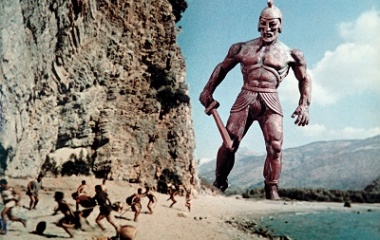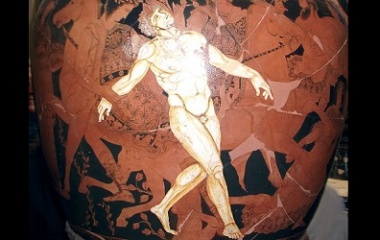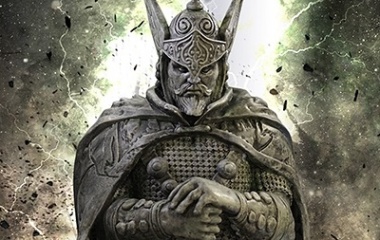Human beings are known to show their affection for one another by way a warm, loving embrace. But if you received a hug from the giant Greek automaton, Talos, the outcome would be much less favorable! The bronze legend would crush and burn you to death at the same time in his steely grip!
What Is Talos?
Talos is a giant automaton in Greek Mythology who protected Crete from invaders. The word Talos means sun in the Cretan dialect, much like Helios in Greek. In other sources Talos is also considered to be a sacred bronze bull, a remnant from the Bronze Age. The nephew of the famous inventor Daedalus shared the name Talos too.
Origin
Sources claim the creator of Talos was either Zeus himself, or one of the inventors, Hephaestus or Daedalus, on Zeus’ orders. In one version of the legend, Talos is a gift from Zeus or Hephaestus to Minos, the King of Crete, to protect the island and its people. Other sources say Talos was a gift from Zeus to Europa to protect her and her children.
Appearance
Talos was a giant robot constructed of brass. On ancient coins he is depicted as a naked, winged man, but is un-winged in paintings. He had a vein which ran from his neck down to his ankles, and which contained liquid metal or ichor – his life source. The vein was secured by a bronze nail in each ankle. The golden fluid that coursed through this vein was considered the life blood of the gods and was believed to be toxic to mortals.
Artisans used a method of hollow-bronze casting during the same period which could reveal a link to the nails in the automaton’s ankles. In hollow-bronze casting, a model was first created in clay, before the core was coated with wax. The model was then stabilized by iron or bronze rods which were pushed through the wax and projected out like pins. It was then covered in an outer layer of clay and heated in order to remove all the wax, leaving a hollow inside. The model was reheated for a longer period, and then the molten metal was poured into the mold. The bronze nails projecting like pins from Talos’ ankles closely resemble the rods used in this ancient casting method.
Purpose
Talos was tasked with protecting Crete from invaders. Three times a day, he circled the whole island! This was an extraordinary feat, as Crete is over 3000 miles². The robot would have had to travel at 155 miles per hour to get around the island three times a day! Apparently Crete didn’t have any walls surrounding it for protection, but the island did have something better – Talos! When foreign ships approached the Cretan coastline, he would ambush them by throwing giant boulders off the cliffs at their vessels. If that was not a sufficient deterrent or failed to destroy the enemy, he had a secret weapon! He would jump into a blazing fire and heat up his metal exterior until it was red hot. The intruders would then be subjected to his legendary deathly embrace and be both crushed and burned to death at the same time. The victim’s charred corpse would be left with a distinctive look of pure terror and pain on its face.
Another important role Talos played on the island was to help enforce the divine law. He would carry massive bronze tablets with all the laws inscribed on them to all the villages on the island three times a year.
Talos’ Defeat
A massive metal robot would surely be impossible to kill by traditional means and, as it was, the eventual defeat of Talos was the result of trickery. The defender of Crete succumbed to the chicanery of the powerful sorceress, Medea. Medea was accompanying Jason and the Argonauts to Crete on the ship Argo. They had just obtained the Golden Fleece and desperately needed to get fresh water and other supplies as they neared Crete. Though Jason pleaded with Talos for the provisions they were in dire need of, and promised they would get off the island as quickly as possible, this did not agree with Talos’ agenda. He began to hurl rocks at their vessel as they neared his domain. Medea was their only hope. She began to charm Talos with her seductive words. In one version of the tale, Medea promises Talos the one thing he truly seeks – immortality. With this lure, she eventually gets him to remove the bronze peg from his ankle. All his life blood drains from his body and he collapses to the ground, dead. In another version, Medea controlled him with her bewitching gaze and had him remove the peg. Alternate versions claim she made him trip, dislodging the peg, or that an arrow was shot into his ankle bringing about his end, like Achilles.
Achilles had a similar vulnerability to the colossal protector of Crete. A poisonous arrow punctured Achilles’ heel, resulting in his death. His mother tried to protect him and make him invulnerable by dipping him into the River Styx as a baby, but the water did not wash over his heel where she held him, making it his weak point, much like Talos.
Sardonic Smile
The origin of the word ‘sardonic’ is said to be linked to the legendary robot, too. He inflicted the customary crushing and fiery demise on a group of Sardinians who tried to attack Crete and left them dead with a petrified grimace. It is said that either the tortured look of his victims or his laugh as he crushed and burnt them brought about this grim association.
Ancient Androids
Hephaestus, the god of the forge, was believed to be Talos’ creator in some sources. He also created other extraordinary feats of engineering and science way beyond his time. He fashioned Zeus’ thunderbolt, a magical cap of invisibility and Achilles’ shield! He was even said to have invented a three-legged copper table that could move by itself! As he had a limp, he also constructed two mechanical handmaidens made of gold that were able to support him. They waited on him, could communicate with him and possessed a vast wealth of knowledge, according to Homer’s Iliad.
Another artful creator, who happened to share the automaton’s name, was the nephew of the famous inventor Daedalus. Talos invented the potter’s wheel, the compass and the saw. The latter he discovered while using a snake’s jaw to cut a narrow piece of wood and decided to replicate the design in metal. His uncle became extremely jealous of his nephew’s skill and brilliant ideas and eventually killed him by throwing him off the Acropolis.
Mystic and philosophical worlds are likewise the domain of a video game called The Talos Principle. The first-person video game features a robot as the main character and immerses the player in a strange mix of advanced technology and ancient ruins to solve complex puzzles.
Robots from ancient or contemporary times are built with the purpose of serving humans. With the advances in the field of Artificial Intelligence, will our robot counterparts eventually develop one of our principal human faults – the desire to be contrary – and want to be more human than machine? Stephen Hawking and the sci-fi community warn that the advances in AI could lead to the destruction of the human race. But, so long as our artificial friends are built with an Achilles’ heel, like Talos, we should be fine, right?











what are his symbols